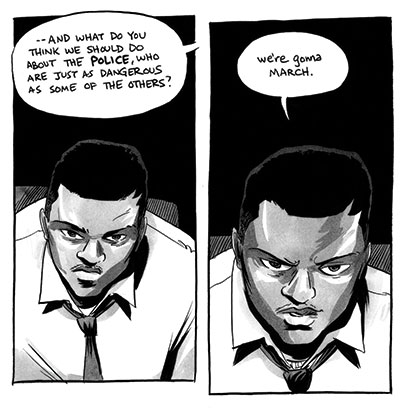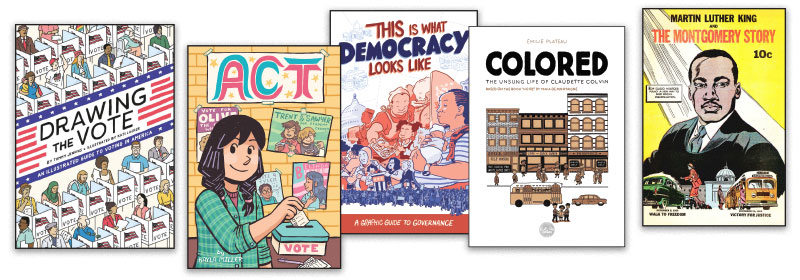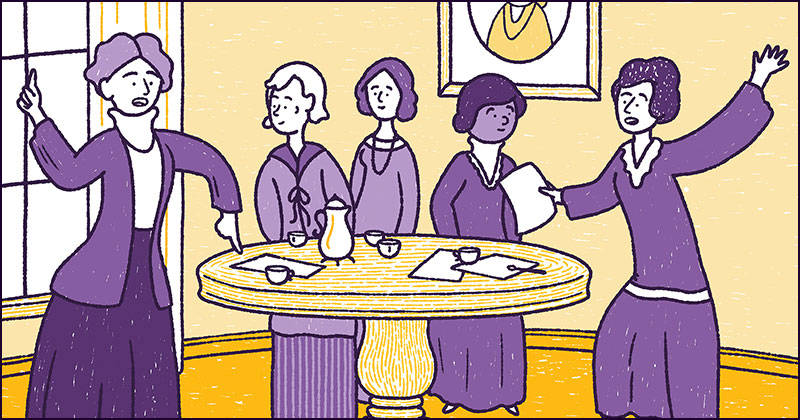We the People: Graphic Novels That Center Democracy, Voting Rights, and Political Activism
In the latest installment of "Stellar Panels," Brigid Alverson recommends graphic works that use the medium to teach how government works and how to change it.

 |
Art from March: Book Two, by John Lewis, Andrew Aydin and Nate Powell (Top Shelf Productions) |
When Rep. John Lewis died in mid-July at the age of 80, he left behind not only a legacy of activism, but also a road map of how to mobilize.
In his three-volume graphic memoir, “March” (Top Shelf; 2013, 2015, 2016), Lewis chronicles his time in the civil rights movement, from the campaign to desegregate the Nashville lunch counters in 1958 to the passage of the Voting Rights Act in 1965. In his retelling, these events expand from points on a time line to stories of struggle, triumph, and sometimes, failure. Often, historical events seem inevitable in retrospect. Of course segregation would be abolished, we think from the vantage point of 2020. But it didn’t look that way in 1958, when the white manager of a lunch counter would have rather closed it down than let a Black person eat there.
“March” illustrates that change requires not merely good intentions, but also planning, training, coalition-building, and learning to apply political pressure. It requires the ability to handle setbacks and take advantage of lucky breaks. It takes persistence and smarts. And it’s far from over: In 2013, the year the first volume of “March” was published, the Supreme Court handed down the Shelby County vs. Holder decision, striking down two provisions of the Voting Rights Act that Lewis and thousands of others worked so hard to achieve. That opened the door to a flood of voter suppression attempts, many focused on people of color.
At the same time, other forces were and are at play. The Russian interference in the 2016 election took the form of disinformation—literal “fake news” that confused voters and encouraged them to stay away from the polls. As we head to the 2020 presidential election, in the midst of a pandemic that will have an unprecedented impact on the voting process, it is more important than ever before that we get it right.
Here is a selection of graphic novels that use the medium to teach how government works and how to change it, and how to make the “good trouble—necessary trouble” that Lewis spoke of so eloquently.
 |
Sample pages from Constitution Illustrated. |
Government and the Constitution
Constitution Illustrated, by R. Sikoryak (Drawn & Quarterly, Jul. 2020)
Gr 7 Up –This book includes the full text of the Constitution, presented one or two paragraphs at a time by characters drawn in classic comics styles, from the Yellow Kid to Dog Man. Sikoryak has a talent for mimicking the work of other artists, and he uses the characters to highlight the meaning of the text in different ways: A clause about taxes is illustrated with Scrooge McDuck waist-deep in gold coins. Someone gets tossed out a window to depict impeachment, and the three-fifths compromise is shown as a Black man literally disappearing. It’s an odd little book, but a thought-provoking way to read the original document. Back matter includes notes on the comics that inspired each page and indicates parts of the Constitution that were later changed, as well as a time line and a bibliography.
Fault Lines in the Constitution: The Graphic Novel, by Cynthia Levinson & Sanford Levinson, illus. by Ally Shwed (First Second, Sept. 2020)
Gr 6 Up –A 101-year-old woman is turned away from the polls; a family with a child with Down syndrome loses its Medicaid coverage. Each chapter of this book starts with a different situation before explaining the underlying structural problems—for instance, flashing back to the debates at the Constitutional Convention of 1787, then moving forward to show how the decisions made then played out later, sometimes blocking attempts at reform. The narrative pauses to examine the specifics of the problem and show alternatives used by other countries or individual states. The book concludes with a debate between the authors as to whether a constitutional convention is necessary, as well as a bibliography. The Levinsons also offer updates on their blog, faultlinesintheconstitution.com . This graphic novel is an adaptation of a prose book first published in 2018, which was an Orbis Pictus Honor Book. It is the second title in First Second’s “World Citizen Comics” series.
Drawing the Vote: An Illustrated Guide to Voting in America, by Tommy Jenkins, illus. by Kati Lacker (Abrams ComicArts, Apr. 2020)
Gr 8 Up –Jenkins, a college professor who lives in North Carolina, begins by reflecting on his students’ enthusiasm for voting in 2008 and their lack of motivation in 2016, and then he gives the reader a guided tour through the history of the American voting system. He covers topics such as voter suppression, women’s suffrage, and gerrymandering. Back matter includes source notes and links to the official voting sites for all states.
This Is What Democracy Looks Like (Center for Cartoon Studies, 2019)
Gr 7 Up –This 32-page booklet is a lively, easy-to-follow explanation of how government works at the federal, state, and local levels, as well as how ordinary people can get involved—and why they should. Aligned with the Common Core standards, the work includes a resource section in the back. It is downloadable from Gumroad.com with a pay-what-you-want format, and print copies can be ordered in bulk. A teacher’s guide is available at the same link.

Activism and Advocacy
Act, by Kayla Miller (HMH, Jul. 2020)
Gr 3-7 –Act, the third book in the series that also includes Click and Camp, shows how students can change the world around them. Spurred by the realization that lack of funds prevents her and other students from joining their classmates on a field trip, Olive tries to persuade her teacher and principal to waive the fee, then runs for student council and launches a fund-raiser to pay for the trips. Some of the other students don’t take her seriously. Her opponents in the campaign are running on a silly platform (more chocolate pudding in the cafeteria), and Olive’s activism strains some friendships—all of which feels realistic. It’s an entertaining story that also lays the foundation for looking critically at politics, both in the realm of school elections and in the adult world. Back matter includes a brief history of protests, a bibliography, and a recipe for mint chocolate chip cookies.
Colored: The Unsung Life of Claudette Colvin, by Emilie Plateau (Europe Comics, 2019)
Gr 7 Up–Before there was Rosa Parks, there was Claudette Colvin. In 1955, when she was a 15-year-old high school student in Montgomery, AL, Colvin refused to give up her seat on a bus to a white person. A local lawyer and the NAACP offered to take up her case, but Colvin was considered a less than ideal figurehead for the movement, especially after she got pregnant. A few months later, Rosa Parks (a member of the NAACP who had worked on Colvin’s case) did the same thing and sparked the Montgomery Bus Boycott. This quiet, yet potent, graphic novel is presented as a series of small drawings that float on the white pages, with text underneath or in borderless word balloons. Like “March,” it goes behind the scenes of the civil rights movement, in this case highlighting an incident that did not become a cause célèbre but inspired further action. It is available only digitally, including on Kindle, and was nominated for an Eisner Award for best digital comic. First Second also has plans for a graphic novel about Colvin as part of its “History Comics” line, and Capstone Press published a comics biography for younger readers, Claudette Colvin Refuses to Move, in August 2020.
Martin Luther King and the Montgomery Story, by Alfred Hassler and Benton Resnick, illustrated by Sy Barry (Fellowship of Reconciliation, 1957)
Gr 5 Up–This is the comic that inspired John Lewis personally and moved him to write the “March” trilogy. Published by the pacifist group Fellowship of Reconciliation, it includes a brief story about the boycott followed by a primer on nonviolent resistance. The 24-page comic is available for $1.99 on ebook platforms such as comiXology and Kindle.
Unrig: How to Fix Our Broken Democracy, by Daniel G. Newman, illus. by George O’Connor (First Second, July 2020)
Gr 10 Up–With this first graphic novel in First Second’s “World Citizen Comics” series, O’Connor, best known as the writer of the “Olympians” series, looks at the power imbalances that cause government to work for the benefit of businesses and lobbying groups rather than ordinary people. The creators also explore alternatives and solutions, such as clean financing of elections. There are extensive notes in the back, and further information can be found at unrigbook.com.
Digital Resources
|
|
|
The Nib (thenib.com) is a daily comics site that focuses on topics in the news and often publishes informational articles. Some examples:
Josh Neufeld (joshcomix.com) creates nonfiction comics about topics in the news, including media literacy and data privacy. His print work includes The Influencing Machine: Brooke Gladstone on the Media (Norton, 2011). |
Draw Out the Vote by various cartoonists (Oni, 2018; drawoutthevote.com) This comics project by a variety of creators takes the form of a map of the U.S. Each state is a link that takes the reader to a short comic and links to election information. Note: This website doesn’t appear to have been updated, so all information should be checked, particularly dates and voting requirements. The links to voter registration and information sites are still a good resource. Ballot Battles: A Cartoon History of Voting Rights (with Lesson Plan) by Andy Warner, on the KQED website (kqed.org). Cartoon the Vote (cartoonthevote.com) has editorial cartoons about voting and elections. Running for Office: It’s Like a Flamewar with a Forum Troll, but with an Eventual Winner by Sean Tevis is a fund-raising site about Tevis’s (unsuccessful) run for Congress in 2008. Drawn in a stick-man style similar to the webcomic xkcd, it shows Tevis’s experiences of declaring his candidacy and raising money. Note: This website includes a “donate” link, although Tevis last ran for Congress in 2010. This would be a good prequel to Unrig. What the President Did to Get Impeached and Acquitted by Josh Adams and Anthony Del Col brings together a number of news reports into a single narrative, with sources included at the end. This ran on the Insider website. |

The job outlook in 2030: Librarians will be in demand
The job outlook in 2030: Librarians will be in demand
ALREADY A SUBSCRIBER? LOG IN
We are currently offering this content for free. Sign up now to activate your personal profile, where you can save articles for future viewing


 How the Suffragists Succeeded in a Pandemic by Allyson Shwed
How the Suffragists Succeeded in a Pandemic by Allyson Shwed



Add Comment :-
Be the first reader to comment.
Comment Policy:
Comment should not be empty !!!